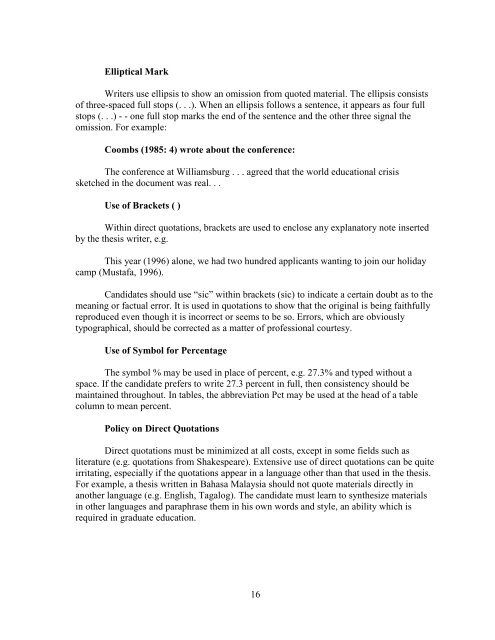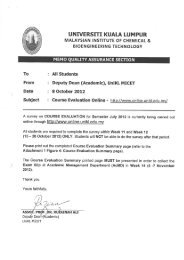guide to the preparation of thesis - UniKL MICET E-learning ...
guide to the preparation of thesis - UniKL MICET E-learning ...
guide to the preparation of thesis - UniKL MICET E-learning ...
You also want an ePaper? Increase the reach of your titles
YUMPU automatically turns print PDFs into web optimized ePapers that Google loves.
Elliptical Mark<br />
Writers use ellipsis <strong>to</strong> show an omission from quoted material. The ellipsis consists<br />
<strong>of</strong> three-spaced full s<strong>to</strong>ps (. . .). When an ellipsis follows a sentence, it appears as four full<br />
s<strong>to</strong>ps (. . .) - - one full s<strong>to</strong>p marks <strong>the</strong> end <strong>of</strong> <strong>the</strong> sentence and <strong>the</strong> o<strong>the</strong>r three signal <strong>the</strong><br />
omission. For example:<br />
Coombs (1985: 4) wrote about <strong>the</strong> conference:<br />
The conference at Williamsburg . . . agreed that <strong>the</strong> world educational crisis<br />
sketched in <strong>the</strong> document was real. . .<br />
Use <strong>of</strong> Brackets ( )<br />
Within direct quotations, brackets are used <strong>to</strong> enclose any explana<strong>to</strong>ry note inserted<br />
by <strong>the</strong> <strong>the</strong>sis writer, e.g.<br />
This year (1996) alone, we had two hundred applicants wanting <strong>to</strong> join our holiday<br />
camp (Mustafa, 1996).<br />
Candidates should use “sic” within brackets (sic) <strong>to</strong> indicate a certain doubt as <strong>to</strong> <strong>the</strong><br />
meaning or factual error. It is used in quotations <strong>to</strong> show that <strong>the</strong> original is being faithfully<br />
reproduced even though it is incorrect or seems <strong>to</strong> be so. Errors, which are obviously<br />
typographical, should be corrected as a matter <strong>of</strong> pr<strong>of</strong>essional courtesy.<br />
Use <strong>of</strong> Symbol for Percentage<br />
The symbol % may be used in place <strong>of</strong> percent, e.g. 27.3% and typed without a<br />
space. If <strong>the</strong> candidate prefers <strong>to</strong> write 27.3 percent in full, <strong>the</strong>n consistency should be<br />
maintained throughout. In tables, <strong>the</strong> abbreviation Pct may be used at <strong>the</strong> head <strong>of</strong> a table<br />
column <strong>to</strong> mean percent.<br />
Policy on Direct Quotations<br />
Direct quotations must be minimized at all costs, except in some fields such as<br />
literature (e.g. quotations from Shakespeare). Extensive use <strong>of</strong> direct quotations can be quite<br />
irritating, especially if <strong>the</strong> quotations appear in a language o<strong>the</strong>r than that used in <strong>the</strong> <strong>the</strong>sis.<br />
For example, a <strong>the</strong>sis written in Bahasa Malaysia should not quote materials directly in<br />
ano<strong>the</strong>r language (e.g. English, Tagalog). The candidate must learn <strong>to</strong> syn<strong>the</strong>size materials<br />
in o<strong>the</strong>r languages and paraphrase <strong>the</strong>m in his own words and style, an ability which is<br />
required in graduate education.<br />
16




